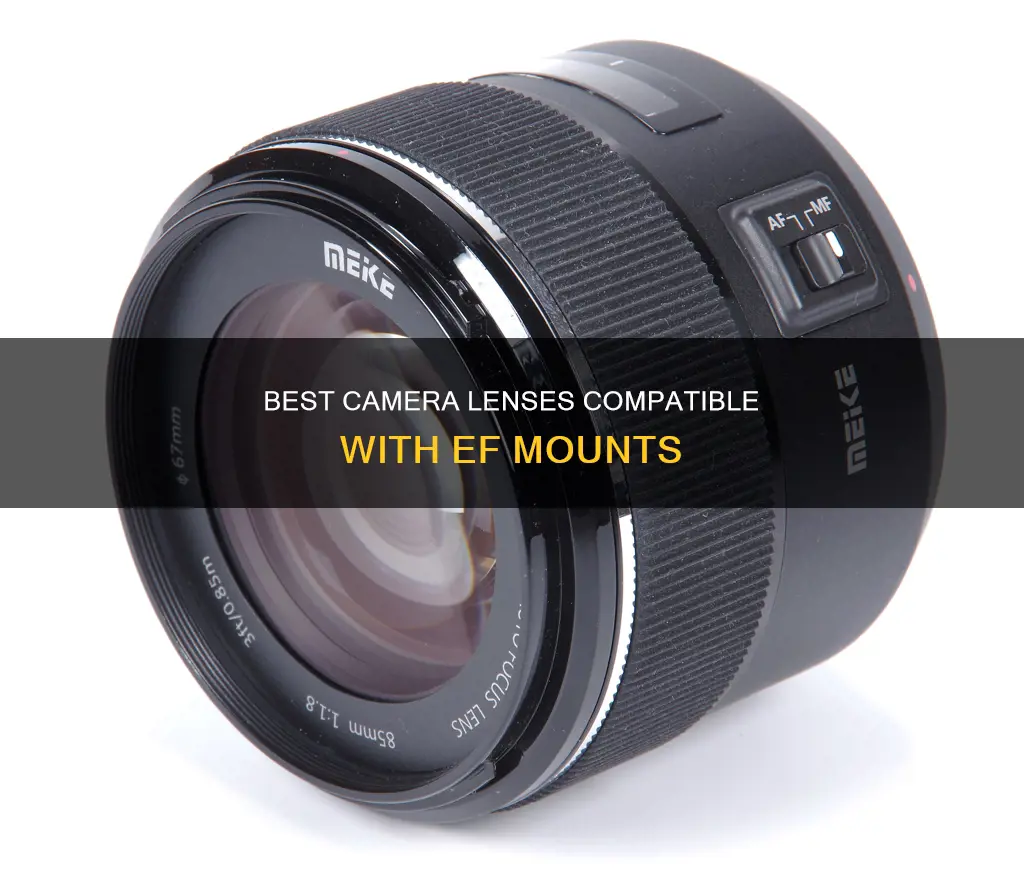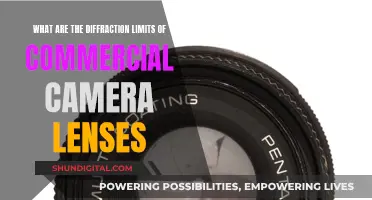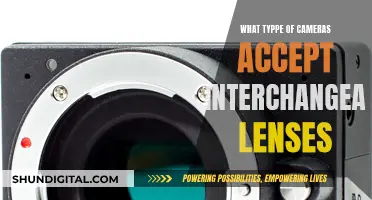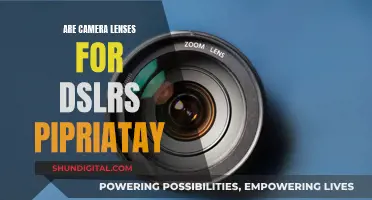
Canon cameras have four mount types, and the easiest way to find out which lenses your camera will accept is to look at the lens mount index on the front of your EOS camera. If your camera has a red line on the lens mount, it is an EOS APS-C R System or EOS Full-frame R System mirrorless. A red circle and a white square on the lens mount indicate an EOS APS-C DSLR, while an EOS full-frame DSLR will only have a red circle. If you have an EOS M series APS-C mirrorless, you will see a white circle on the lens mount. Canon lens adapters offer full compatibility with Canon EF, EF-S, TS-E, and MP-E lenses, giving Canon EOS R System and EOS M series camera owners complete integration with their existing lenses.
| Characteristics | Values |
|---|---|
| Camera | Canon EOS |
| Lens | EF |
| Mount Types | 4 |
| Mount Types Examples | Red line on lens mount, red circle and white square on lens mount, red circle on lens mount, white circle on lens mount |
| Camera Types | EOS APS-C R System, EOS Full-frame R System mirrorless, EOS APS-C DSLR, EOS full-frame DSLR, EOS M series APS-C mirrorless |
| Adapter | EF-EOS R Adapter, Control Ring Mount Adapter EF-EOS R, Drop-In Filter Mount Adapter EF-EOS R, EF-EOS M Adapter |
| Lens Types | EF-S, TS-E, MP-E |
What You'll Learn
- Canon EF-S mount is compatible with some Canon DSLRs with APS-C sensors
- Canon EF lenses can be used with EF-S mount cameras
- Canon EOS R System and EOS M series cameras are compatible with EF lenses
- Canon EF-S lenses cannot be mounted on DSLRs with sensors larger than APS-C
- Canon EF-S mount is a relatively new offering from Canon

Canon EF-S mount is compatible with some Canon DSLRs with APS-C sensors
The Canon EF-S lens mount is compatible with some Canon DSLRs with APS-C sensors. Canon cameras have four mount types. If your camera has a red circle and a white square on the lens mount, it is an EOS APS-C DSLR, which is compatible with the EF-S mount.
The EF-S mount is a derivative of the EF mount, which was created for Canon DSLRs with APS-C-sized image sensors. It was released in 2003, and cameras with this mount are backward compatible with EF lenses. The "S" in EF-S stands for "Small image circle" or "Short back focus". The small image circle refers to the lens projecting a smaller image circle than normal EF lenses to match the sensor. The short back focus refers to the smaller mirror in APS-C cameras, which allows optical elements to protrude further into the camera body, reducing the minimum distance between the sensor and the back element of the lens. This combination of a smaller sensor and shorter back focal length distance enhances the possibilities for wide-angle and very wide-angle lenses.
EF-S mount lenses can be made smaller, lighter, faster, and less expensive than EF lenses. However, they cannot be mounted on DSLRs with sensors larger than APS-C. Only Canon cameras released after 2003 with APS-C-sized sensors support the EF-S mount. It is physically impossible to mount EF-S lenses on EF-only cameras due to the increased proximity of the lens to the sensor, which would obstruct the mirror's movement and cause damage.
Some of the cameras that can use the EF-S mount include the EOS 300D/Digital Rebel, EOS 350D/Digital Rebel XT, EOS 400D/Digital Rebel XTi, and EOS 4000D/Rebel T100. The EF-S lens mount is a relatively new offering from Canon, so the selection of available lenses is limited compared to the full EF range. However, it is backward compatible with the EF mount and can accept all EF lenses.
Lenses and Cameras: Powering Photography Together
You may want to see also

Canon EF lenses can be used with EF-S mount cameras
Canon EF lenses are compatible with EF-S mount cameras, but only when used with the appropriate lens adapter. Canon cameras have four mount types, and the easiest way to find out which lenses your camera will accept is to look at the lens mount index on the front of your EOS camera.
If your camera has a red circle and a white square on the lens mount, it is an EOS APS-C DSLR. If it has only a red circle, it is an EOS full-frame DSLR. If you see a white circle on the lens mount, your camera is an EOS M series APS-C mirrorless.
Canon EF-S is a derivative of the EF lens mount, created for some Canon digital single-lens reflex cameras with APS-C-sized image sensors. It was released in 2003, and while EF-S mount cameras are backward compatible with EF lenses, EF-S lenses cannot be mounted on DSLRs with sensors larger than APS-C.
Canon lens adapters offer full compatibility with Canon EF, EF-S, TS-E, and MP-E lenses, giving Canon EOS R System and EOS M series camera owners complete integration with their existing lenses. The standard Mount Adapter EF-EOS R allows EF, EF-S, TS-E, and MP-E lenses to be used on EOS R System cameras.
The Control Ring Mount Adapter EF-EOS R offers the same lens mount conversion as the standard Mount Adapter EF-EOS R, but it also adds a lens control ring. The Drop-In Filter Mount Adapter EF-EOS R adds the ability to use drop-in filters to the functionality of the standard Mount Adapter EF-EOS R.
The Mount Adapter EF-EOS M is a small, lightweight EF-M mount adapter that allows you to attach any lens from Canon's EF, EF-S, TS-E, and MP-E range to the EOS M series camera.
Attaching Camera Lens Covers: A Step-by-Step Guide
You may want to see also

Canon EOS R System and EOS M series cameras are compatible with EF lenses
Canon's EF lens mount was introduced with the launch of the EOS system in 1987. This was the beginning of the single biggest native lens system for an interchangeable lens camera. Canon EOS camera owners could be assured that any EF lens would fit their camera.
Over time, the range of Canon camera lenses expanded, and the company introduced the EOS R System and the EOS M series cameras. These cameras are compatible with EF lenses, but they require a lens adapter. Canon offers a range of lens adapters, including the standard Mount Adapter EF-EOS R, the Control Ring Mount Adapter EF-EOS R, and the Drop-In Filter Mount Adapter EF-EOS R. These adapters allow Canon EF, EF-S, TS-E, and MP-E lenses to be used on the EOS R System cameras.
For the EOS M series cameras, Canon offers the Mount Adapter EF-EOS M, a small and lightweight adapter that enables the use of EF lenses on this mirrorless camera system.
It is important to note that while the EOS R System and EOS M series cameras are compatible with EF lenses via adapters, there may be additional limitations when using dedicated APS-C lenses on Full-frame EOS R cameras. Photographers are advised to refer to their camera's user manual for specific details regarding lens compatibility and any potential restrictions.
Canon's extensive range of lenses, including the compatibility of EF lenses with newer camera systems, provides photographers with a wide array of creative possibilities and ensures they can find the ideal lens for their desired shots.
UV Light: Friend or Foe to Camera Lenses?
You may want to see also

Canon EF-S lenses cannot be mounted on DSLRs with sensors larger than APS-C
Canon offers four types of lens mounts for its EOS cameras: the EOS APS-C R System or EOS Full-frame R System mirrorless, the EOS APS-C DSLR, the EOS full-frame DSLR, and the EOS M series APS-C mirrorless. The lens mount index on the front of your EOS camera will tell you which type of mount your camera has.
The Canon EF-S lens mount was introduced in 2003 for some Canon digital single-lens reflex cameras (DSLRs) with APS-C-sized image sensors. The "S" in EF-S stands for either "Small image circle" or "Short back focus". The small image circle refers to the lens projecting a smaller image circle than normal EF lenses to match the sensor. The short back focus refers to the smaller mirror in APS-C cameras, which allows optical elements to protrude further into the camera body, reducing the minimum distance between the sensor and the back element of the lens.
While EF-S lenses are backward compatible with the EF mount, they cannot be mounted on DSLRs with sensors larger than APS-C. This is due to the increased proximity of the lens to the sensor, which would cause the lens to obstruct the mirror's movement and damage the lens and/or camera. Although some people have reported success in attaching EF-S lenses to full-frame bodies using an extension tube or by removing a small plastic ring, vignetting remains an issue and the lens's ability to achieve infinity focus is compromised.
It is important to note that not all Canon EF-S lenses utilise the short back focal length. Some third-party manufacturers may feature the standard EF mount if their lenses do not have a shorter back focal length but only have a small image circle. Vignetting or unsharp outer areas may occur if these lenses are used on 35mm film or full-frame sensor cameras.
Choosing the Right Camera Lens: Capturing Perfect Shots
You may want to see also

Canon EF-S mount is a relatively new offering from Canon
Canon cameras have four mount types, and the EF lens mount was introduced with the launch of the EOS system in 1987. The Canon EF-S lens mount is a relatively new offering from Canon, released in 2003. It is a derivative of the EF lens mount created for some Canon digital single-lens reflex cameras with APS-C-sized image sensors.
The "S" in EF-S has been described by Canon as either standing for "Small image circle" or "Short back focus". The small image circle description refers to the lens projecting a smaller image circle than normal EF lenses to match the sensor. The short back focus description refers to the smaller mirror in APS-C cameras, which allows optical elements to protrude further into the camera body, reducing the minimum distance between the sensor and the back element of the lens. This combination of a smaller sensor and shorter back focal length distance enhances the possibilities for wide-angle and very wide-angle lenses.
EF-S mount cameras are backward compatible with EF lenses, meaning they can accept all EF lenses. However, EF-S lenses cannot be mounted on DSLRs with sensors larger than APS-C. Cameras that can use the EF-S mount include the EOS 300D/Digital Rebel, EOS 350D/Digital Rebel XT, EOS 400D/Digital Rebel XTi, EOS 4000D/Rebel T100, Blackmagic Pocket Cinema Camera 6K, and Blackmagic Studio Camera 6K Pro.
The EF-S lens mount is relatively new, so the selection of available lenses is more limited compared to the full EF range. The variety of EF-S prime lenses is particularly limited in comparison to EF-S zoom lenses, with three primes to nine zooms. EF-S lenses are very popular due to their lower cost, and zoom lenses are preferred by amateur photographers.
Canon Cameras: Do They Include Lens Caps?
You may want to see also
Frequently asked questions
The easiest way to find out is to look at the lens mount index on the front of your EOS camera. Simply remove the lens from your camera by pressing the lens release button and twisting the lens anti-clockwise.
There are four types of Canon camera lens mounts:
- EOS APS-C R System or EOS Full-frame R System mirrorless (indicated by a red line on the lens mount)
- EOS APS-C DSLR (indicated by a red circle and a white square on the lens mount)
- EOS full-frame DSLR (indicated by only a red circle on the lens mount)
- EOS M series APS-C mirrorless (indicated by a white circle on the lens mount)
The EOS R System is compatible with Canon EF, EF-S, TS-E, and MP-E lenses when used with the appropriate lens adapter.
The EF-S lens mount is a derivative of the EF lens mount, designed for Canon digital single-lens reflex cameras with APS-C-sized image sensors. EF-S lenses cannot be mounted on DSLRs with sensors larger than APS-C.
Yes, some third-party manufacturers produce lenses with the standard EF mount, but they may have a smaller image circle, which can cause vignetting on full-frame sensor cameras.







